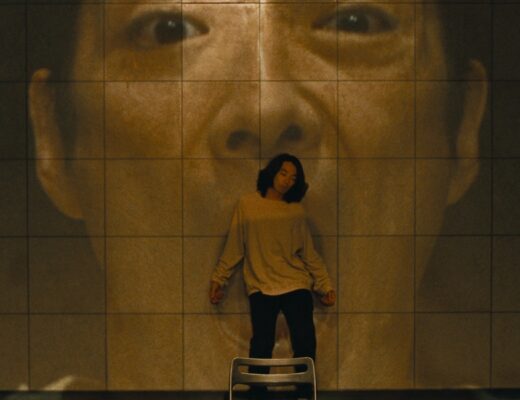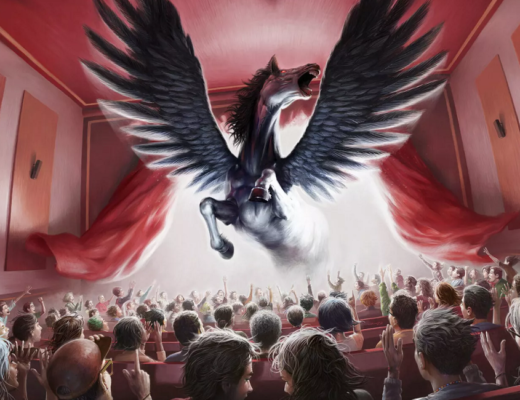While he appeared in many of his own cinematic works (including one of his most well-known, 1968’s Razor Blades), multi-media artist Paul Sharits didn’t primarily produce work about people. He made films — including looping museum installations and dual-projector projects (the aforementioned Razor Blades) — about film. No, not the common colloquialism for “film,” which we typically adopt to refer to a commercial, feature-length narrative work: rather, Sharits was concerned with exploring, as he put it, “celluloid, two-dimensional strips; individual rectangular frames; the nature of sprockets and emulsion; projector operations; the three-dimensional light beam; environmental illumination; the two-dimensional reflective screen surface; the retinal screen; optic nerve and individual psycho-physical subjectivities of consciousness.” He considered narrative cinema to be as worthless as filmed theater and, more or less, a general bastardization of the specific material qualities the art form provided. And so, he utilized these listed physical features to make art that assaulted the viewer’s visual and auditory systems, to take them out of the lulling comfort of diegetic fiction and into the world of reality. The types of work he made ranged from his early intense flicker films to his pedagogical “Analytic Color Studies,” from off-putting late-period music videos to excursions in abrasive sound.
His first major accomplishment, which lead toward these later polar extremities in his career, was 1971’s S:TREAM:S:S:ECTION:S:ECTION:S:S:ECTIONED — which was the first of his films to feature actual moving images as opposed to the his “mandala films,” which featured rapidly shifting color frames intercut with black-and-white representational images. It’s also, probably, his most ambitious and accomplished filmic undertaking, made after a brief professional hiatus influenced by a myriad of personal issues. That it’s one of Sharits longest films as well only attests to the artistic rigor of the structural enterprise (1986’s Figment I: Fluxglam Voyage in Search of the Real Maciunas, is listed at nearly three hours, but that was shot on video).
After a brief title card — the only use of written language throughout the film — we’re presented with our first image: rushing water from a steam. Indeed, to be more accurate, this descriptor in itself might be something of a false pretense; this seemingly singular image is actually six different superimposed recordings of the same stream, with each layered current running water in a different direction. In perhaps would make more sense, then, to consider this the first movement: over the span of the next 14 minutes, each one of these overlapped images slowly fades until only one remains, and the cycle then begins anew after this specific duration, repeating three times in full, resulting in three entire, independent movements. There’s no sense of where this water is coming from or even where it’s going, and that’s ultimately irrelevant to the rest of the proceedings, as this lack of clarity creates a space of uncertainty that is essential to the scope of Sharits’ objectives.
As these images collide across each other, we begin to hear a voice: it’s feminine, almost drone-like in its monotone inflection, but with a stern sense of authority. This voice says only one word throughout this brief section — one of many that will end up encompassing the entire work: “exochorion.” She keeps repeating it, with the same dead-pan articulation and never once altering the timbre of her voice. It soon becomes meaningless, in the same way that any repeated word become a mere unit of language, rolling off your tongue in such a way that its existence demands scrutiny: why is it pronounced the way it is, and, ultimately, what’s the significance of speaking a word (purely sonic attributes) versus the a/effects said word can have in an outside context (a purely meaning-based understanding)? And while the word “exochorion” does have a specific meaning — it’s the outer of the two layers that form the hardened covering of an insect egg, for those not fresh in their bug-centric etymology — it has no relation to the images we’ve been provided thus far. When attempting to consider this on both a theoretical and aural plane, the expression has been rendered useless; the certainty of this voice has thus been called into question, not because of the falsity of what’s being said or because we think someone else is saying it, but because it’s so destabilized in a logical and contextual sense that it comes off as borderline flippant.
It’s here that Sharits creates a double bind conflict, one of the many that preoccupy S:TREAM:S:S:ECTION:S:ECTION:S:S:ECTIONED: first, that of human (the voice) versus nature (the images of the stream); second, that of auditory comprehension versus visual understanding. After about seven minutes, Sharits decides to complicate things further by introducing more stray elements, that, on their own, each appears quite plain: by scratching directly onto the film’s celluloid emulsion of the streaming water, three vertical black lines now appear on the screen, which covers the two-dimensional apparatus from top to bottom. Over the remaining runtime, seven more sets of three will appear. We now have a struggle that’s operating alongside the previously stated two, one between the materiality of the film itself and the projected image of the water. Space becomes even more destabilized, and soon, one loses track of the superimpositions of the stream and instead fixates on the relation between these lines and the currents, the horizontal flow of the water as it clashes against the towering white strokes that ultimately cover the entirety of the screen, which Sharits himself described as “[a] conceptual lap dissolve from ‘water currents’ to ‘film strip current.’”
On an aural level, more conflicts begin to emerge: after seven minutes, there’s a loud, rather harsh beeping noise that occurs in tandem with how many frames of the moving water remain in total. To complicate things further, every seven minutes (if you couldn’t tell by now, Sharits is rather particular with how each of these elements are introduced and expounded upon) the same voice starts to say and loop other words that sound eerily similar to “exochorion” — “exodontia,” “exogenous,” “exostosis,” etc. — and soon, not just the words themselves lose meaning, but the entity of the human voice itself becomes nonsensical in regards to the function of auditory language, as each word begins to slur into the next. The voice heard here no longer instills certainty on its own; it has become an agent of chaos amongst a sea of already-existent ambiguity.
Since all of these stray elements are ultimately intertwined together as they meet and interact with one another within the realm of the cinematic apparatus — and considering the basic rules of narrative logic one may wish to apply here — a spectator might attempt to receive the voices or noises as in connection with something happening on screen. When the second looped word is introduced, it occurs after there are already three lines on the screen; an educated guess one might make here would be that the voice is coming from one of these lines, to imagine that they’re “speaking,” so to say, to try and instill some sense of order to the disorder. Obviously, the lines themselves aren’t producing these words, nor do they even have anything remotely tangible in a sense of a direct relationship to the voice speaking them. Each of these aspects follows its own internal reasoning, its own specific rules in relation to the runtime of S:TREAM:S:S:ECTION:S:ECTION:S:S:ECTIONED; when all thrown together, there’s no sense of inherent meaning attached to the connectivity of these parts, and instead, one must create their own meaning from this onslaught of senselessness.
But this doesn’t get at the heart of what makes Sharits’ work “beautiful,” as fellow experimental filmmaker Micheal Snow succinctly describes it. All of this technical talk is operating on both an intellectual and formal level: we know what’s happening, and one can reasonably use their cognitive abilities to render what’s so “neat” about the whole project. But what about the actual experience of watching it? In Gary Doberman’s rather juvenile diatribe against structural cinema titled “N.Y. Cut The Crap,” he labels the movement as the “zenith of academic cinema” (he even goes as far to assert that the artists associated with it were members of some Eastern faux-intellectual cabal) in the sense that these were works that their makers — oftentimes instructors at universities who, yes, taught their own films — could cutely explain away like a unit of measurement. However, one would be hard-pressed to contemplate the act of viewing Sharits’ films in such bad-faith terms: there’s a strong emotional undercurrent (pardon the pun) to his work that only becomes apparent whilst viewing, materializing not through specific on-screen actions, but through the viewer’s own relation to the images that have been presented. With S:TREAM:S:S:ECTION:S:ECTION:S:S:ECTIONED — and most structural works in general — what you see is what you get: observing each of these separate parts slowly coalesces into a new audio-visual vernacular result in an experience one will enjoy largely dependent on the amount of effort they’re willing to put in. For those willing to dive in headfirst, it’s a feat that’s as mentally rewarding as it is subjectively stimulating.
Part of Kicking the Canon – The Film Canon.







